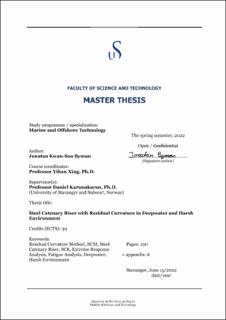| dc.description.abstract | The exploration and production of oil and gas are still high in demand. With the
advancement of subsea technology, it is possible to move into deeper waters and
harsher environments. It highlights the importance of finding riser configurations
that is suitable but also cost-effective. This thesis aims to find a riser configuration
that can handle the large vessel motions of the Floating Production, Storage and
Offloading (FPSO) in a remote, deepwater and harsh environment.
The conventional Steel Catenary Riser (SCR) has been a favored concept for deep
and ultradeep water developments. However, the SCR is very sensitive to large vessel
motions, impacting the downward velocity at the hang-off point. This translates to
a higher velocity in the Touch Down Zone (TDZ) that can induce excessive levels of
stress and fatigue.
An alternative that has been considered is the implementation of residual curvature
sections in the riser using the Residual Curvature Method (RCM). These sections
create a small deformation in the pipe that works as triggers for lateral buckling
and aids in absorbing compressive forces generated. A comparison between the
conventional SCR and the Residual Curvature Steel Catenary Riser (RCSCR) is
performed to evaluate how the residual curvature affects the response in the TDZ.
According to previous works, the conventional SCR with a coating is not able to
cope with a downward velocity above 2.33 m/s. The implementation of Residual
Curvature (RC) to the riser showed that it could cope with downward velocities up
to 3.35 m/s at the hang-off point. Moreover, the fatigue performance was analyzed
for wave-induced fatigue. Neither the SCR nor the RCSCR had an expected fatigue
life above the acceptance criteria of 250 years.
Overall, this thesis has shown that the RCSCR improved the strength performance
in the TDZ and improved the riser’s ability to cope with large vessel motions. For
fatigue performance, the RCSCR did not meet the design requirements and still
requires more study.
Keywords: Residual Curvature Method, RCM, Steel Catenary Riser, SCR, Extreme Response Analysis | |
